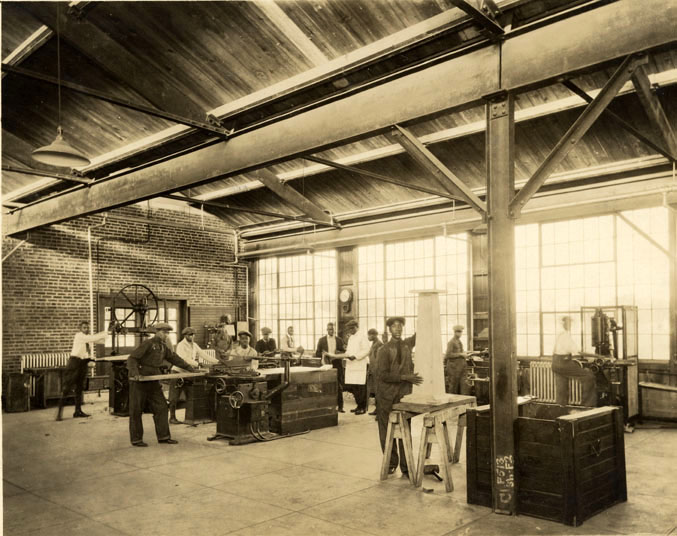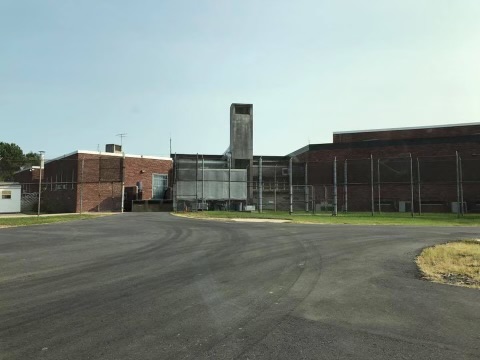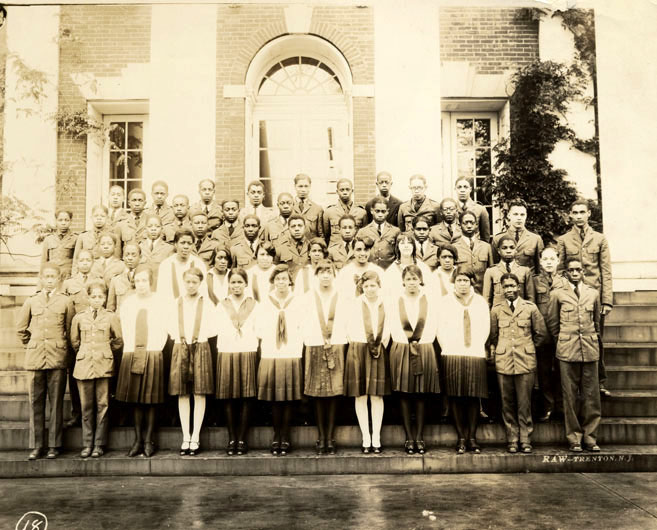You’ve likely seen the viral video by now. A fight between two boys — one Black and one white-presenting — in a Bridgewater, New Jersey mall. What could have been a youthful scuffle soon escalated into something bigger. For me and many others, it was a clear reminder that there are two New Jerseys for our young people, as police swiftly entered the scene and tackled Z’Kye, the Black teen, to the ground. Meanwhile, the teen of lighter complexion looked on from a bench, even standing at one point to observe the officers handcuffing Z’Kye. Later, even he commented on the unequal treatment. “I don’t understand why they arrested him and not me,” he said.
The video clip is short, but the history it speaks to is long — namely, society’s refusal to view our Black kids as kids.
Though we know incidents like this happen every day, that this incident took place during Black History Month made it all the more striking to me. Every February for the past few years, I’ve reflected on the legacy of a historic New Jersey institution less than 50 miles from Bridgewater: the Bordentown School. Nestled on 400 acres in Bordentown, New Jersey, this school was an elite, state-run boarding school for New Jersey’s Black youth, with a legacy of more than 50 years. Founded by formerly enslaved Reverend Walter Rice, the Bordentown School was often called the “Tuskegee of the North” — a reference to Booker T. Washington’s Tuskegee Institute — and educated generations of New Jersey’s Black youth. Visited by such luminaries as Albert Einstein, W.E.B. Du Bois, and Eleanor Roosevelt, the school eventually closed in 1955 following a state constitutional amendment outlawing segregated schools.

And what stands now on the site of the Tuskegee of the North? Hayes, New Jersey’s youth prison for girls. And across the street sits the Juvenile Medium Security Facility, or JMSF — the state’s most secure youth prison for boys. The Bordentown School, in other words, has literally become the school to prison pipeline realized in New Jersey. A powerful moment in history of investment in Black youth, replaced by a damning reminder of the current refusal to invest in these same young people today.
Beyond this jarring juxtaposition, the story of the Bordentown School speaks to our state’s — and nation’s — refusal to provide our young people of color with the resources they need to thrive in their communities. As a result of this disinvestment, children of color are more likely to end up in youth prisons — like Hayes — than their white peers.
And this is indeed the case here in New Jersey, where, just like the Bordentown School resulted in New Jersey being number one for Black education, the state now takes top ranking for a far more insidious reason. New Jersey has the worst Black-to-white youth incarceration disparity rate in the entire nation, with a Black child almost 18 times more likely to be locked up than their white counterpart. This extreme disparity occurs even though Black and white youth commit most offenses at similar rates. A look at the Bridgewater video brings that statistical disparity into real life focus.
While New Jersey has worked diligently to decrease the number of incarcerated youth in the state — with only 102 youth incarcerated in state youth prisons as of February 2022 — Black youth account for over 60% of this total. By contrast, New Jersey locks up only 11 white youth total.

In addition to locking up Black kids at a disproportionate rate, New Jersey’s youth incarceration system also wastes taxpayer dollars. New Jersey’s youth prisons are over 75% empty as of February 2022; at that same time, Hayes only incarcerated six girls. Yet, despite these encouragingly low numbers, the state continues to operate its youth prisons as if at full capacity — with more than 500 paid staff members working across the state’s three youth prisons. According to the latest budget numbers, the state spends almost half a million dollars to incarcerate each young person in a state youth prison, amounting to an annual expenditure of more than $50 million.
Those tax dollars do not seem to be going toward effective attempts at rehabilitation but instead are simply funding a criminogenic cycle, with over one-quarter of youth released from these facilities returning to them within three years. Could it be that the violent nature of youth imprisonment itself is what’s perpetuating the failure to help these kids thrive? As it happens, youth prisons are also dangerous environments for our youth; as just one example, a former youth prison guard recently pleaded guilty to an aggravated assault charge for breaking the wrist of a youth incarcerated in JMSF.
Youth prisons also exact immeasurable emotional trauma on our young people just at the time they need to be healed. Nationally, between 65 and 70 percent of the 2 million children and adolescents arrested each year have a mental health disorder. In 2018, almost a quarter of the young people admitted to JMSF had a mental health diagnosis. These are kids in need of treatment and care, not incarceration.
So what do we do with a youth prison system that perpetuates racial disparities, does not rehabilitate our young people, and wastes millions in taxpayer dollars each year? The answer is obvious: We shut it down. And we build new sources of care that support our young people with meaningful investments in their lives.
The belief that there are no throwaway kids and all kids can be saved, serves as the foundation of New Jersey’s 150 Years Is Enough youth justice campaign. Launched by the New Jersey Institute for Social Justice and its partners on June 28, 2017, on the 150th anniversary of the opening of Jamesburg, the state’s largest youth prison for boys, the campaign is dedicated to closing New Jersey’s three youth prisons and reinvesting funding into communities devastated by youth incarceration.
Half a year after the campaign’s launch, on January 8, 2018, former Governor Chris Christie announced the closure of Jamesburg and Hayes; simultaneously, however, he called for the construction of three smaller youth prisons. Recognizing that our state needs investment in our young people, not in new youth prisons, our campaign sprang into action — successfully stopping the construction of a new youth prison in Newark, New Jersey; working with youth to amplify their own stories about why youth prisons must be abolished; and continuing to build a broad-based coalition focused on youth prison closure and reinvestment.
Tragically, four years after Governor Christie’s closure announcement, all three of New Jersey’s youth prisons remain open. But we currently sit in a powerful moment in time, ignited by the police killing of George Floyd in the summer of 2020. Now is the time for New Jersey to finally close our youth prisons and save our young people.
We know it can be done. Indeed, the advocacy of the 150 Years Is Enough campaign has led to important measures to protect our incarcerated youth during the ongoing pandemic. First, New Jersey became the first state in the nation to test all of its incarcerated youth for COVID-19. Second, more than 100 youth from state facilities were released in response to the risk posed by the virus. And last, in August 2021, to provide needed services for the youth returning to their home communities from incarceration, our campaign’s advocacy resulted in New Jersey passing legislation allocating over $8 million for youth restorative justice hubs in four cities disproportionately harmed by youth incarceration.
But these steps, while significant, are only the beginning. Four years after the closure announcement, New Jersey must finally close our state’s three youth prisons once and for all and invest meaningfully into impacted communities. Expanding opportunities for restorative justice — a practice that focuses on resolving conflicts by bringing together youth who have harmed and those who have caused harm for healing dialogue and resolution — is a big part of that. We should also invest meaningfully in youth mental health programs, community-based violence interrupter programs, and other supportive, non-carceral services.
The kids of Newark deserve as much investment as the kids of Short Hills.
This is what is needed to make Black lives truly matter in the Garden State. The kids of Newark deserve as much investment as the kids of Short Hills.
These are our young people, not nameless statistics. These are young people like Charrnice, a young woman who was incarcerated in Hayes at 16 for four months. While Charrnice was able to advance her education while incarcerated, she also noted that she was subjected to behavior holds that had her confined to her cell for 20 hours a day — including her entire last month of incarceration. When asked about what would be a better way, Charrnice’s answer was clear and unequivocal: programs, not prison. So as we call on New Jersey to stand by its word and close our state’s youth prisons, let us remember Charrnice. Let us remember the Bordentown School. Let us remember Z’Kye. Let us remember the investment that we can make in our children’s uplift — not their downfall. One hundred and fifty years is enough.
Header image: New Jersey State Archives, Department of State.

